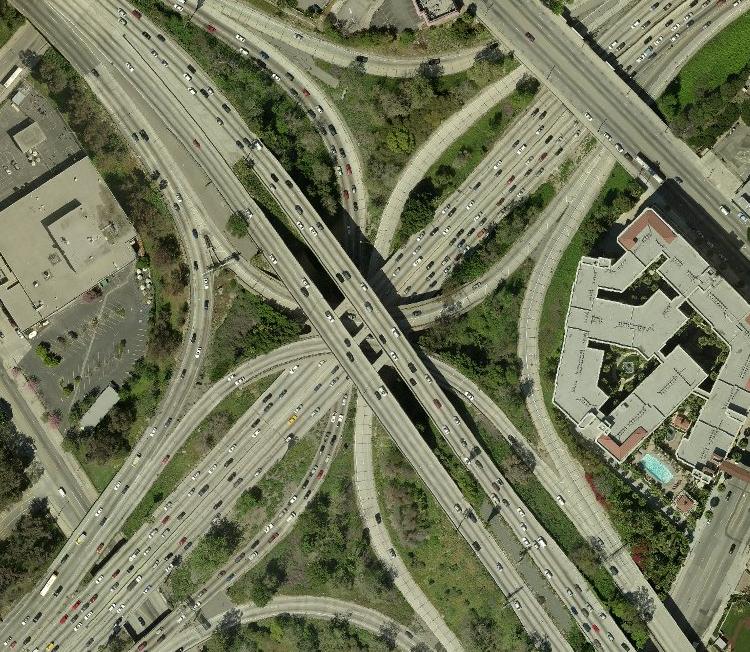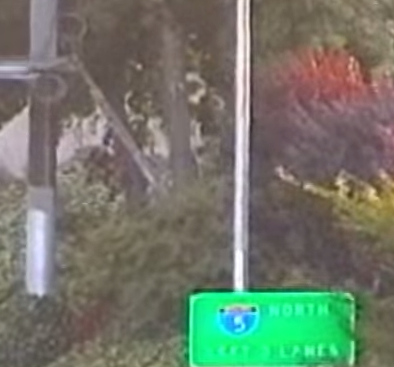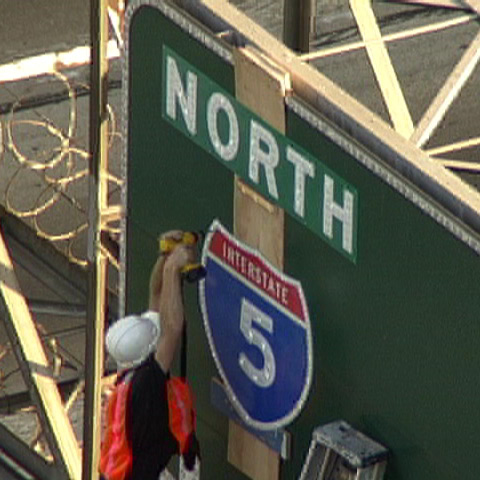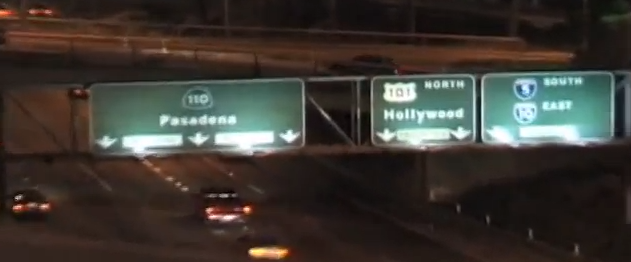An Unsanctioned High 5
In the early 1950s, the predecessor to the California Department of Transportation (colloquially “Caltrans”) opened an innovative solution to Los Angeles’ traffic problems at the junction of U.S. Route 101 and California Highway 110. Called the “Four Level Interchange,” it’s a series of underpasses and bridges which, combined, shove two major multi-lane highways into a relatively small area surrounded by large buildings. Here’s an aerial picture of the interchange from a few years ago:

It looks like a mess but apparently, it’s an improvement over what was there before. Nevertheless, there is always room for further improvement. For example, in 2000 and into 2001, the section of California Highway 110 leading into the Interchange had a problem — inadequate signage, at least if you were hoping to get to Interstate 5 North. That section — it’s at the red flag on this map — used to have overhead signs which looked like this:
If you’re going to California 110, US 101, Interstate 5 South, or Interstate 10 East, you know what line to go into. (Sorry for the image quality — it and the next one are screenshots from a video, linked to below.) But what if you’re going to Interstate 5 North? The sign is silent. Instead, there were a few signs on eye level, although they were often unnoticed by motorists. Take, for example, the sign in the bottom-right corner of the image below. At the time, that sign was on a pole just to the right of the overhead sign pictured above.

It’s hard to read, but the sign says that if you want Interstate 5 North, you want to be in the left three lanes on a five-lane highway. It’s easy to miss, and if you do, you’re probably going to be in the wrong lane until it’s too late.That was the experience of a man named Richard Ankrom, at least. In 2000 or 2001, he missed his exit and, frustrated, decided to do something about it. But unlike most people, who would complain (probably fruitlessly) to Caltrans or a government official, Ankrom took matters into his own hands. Ankrom is an artist — and in this case, his masterpiece was a new sign.
Ankrom studied the relevant highway signage rules — in a surprising example of government adopting a digital outlook, the regulations were all available online even in 2001 — and made a “North” sign and Interstate 5 shield which complied with the guidelines. He donned an orange safety vest, drove to the scene of the sign, and, as seen on below (via his website, here), installed his homemade but real-looking signs in broad daylight.

No one thought anything of it — why would what appears to be a construction worker adding standard-looking signage provoke an inquiry from drivers passing under it? If anything, the sign was a welcome addition to drivers, many of whom now knew how to get to I-5 North. It was an official-looking improvement. Why would drivers suspect otherwise?That’s a sensible outcome. But there was more — drivers weren’t the only ones who didn’t notice that the sign was unofficial. More importantly, for months, Caltrans didn’t either. And the fake sign may have fooled them for months if not years thereafter. The only reason they discovered the ruse as early as they did is because Ankrom leaked the story to a local publication about nine months after installing his creation.
But in the end, Caltrans didn’t seem to mind. Sure, they made a point of pointing out that what Ankrom described as “guerrilla public service” was, by the letter of the law, illegal. But they never pressed charges nor, for that matter, acted to remove what some may have considered vandalism. Ankrom’s additions stayed on the sign until 2009, when Caltrans replaced the entire set of signs on the signpost as part of scheduled maintenance. And the new set, seen here, features the Interstate 5 North lane prominently.
In 2011, Ankrom released a video showing exactly how he made and installed the sign, down to the Pantone colors used and how he turned a pickup truck into something official looking. You can watch the ten-minute video here.
Bonus Fact: Interstate 70 runs from Maryland to Utah and, along the way, crosses through Colorado. Mile marker 420 should be seen on I-70 as one drives through Colorado, but it’s not there. That’s because it often gets stolen, almost certainly due to the number’s association with marijuana. (The origin story for 420 as a pot reference is behind that link.) In response to the repetitive thefts, the Colorado Department of Transportation developed a new mile marker sign. It reads “419.99.”
From the Archives: Moving Pictures: How Hollywood came to Los Angeles.
Related: An Interstate 5 sign (for those who want to engage in “guerrilla public service” but are lazy).

